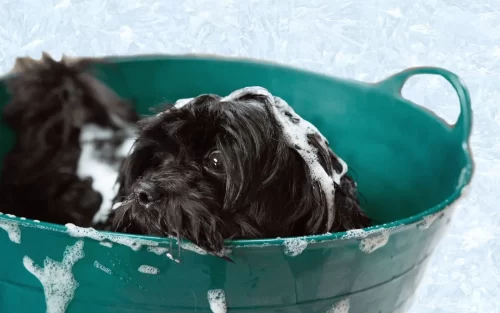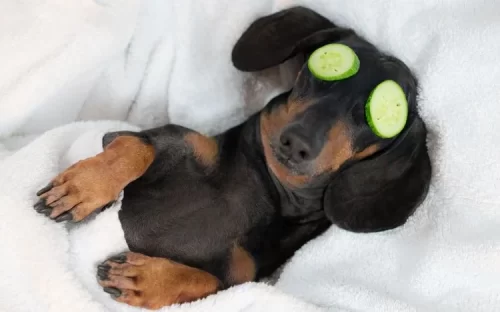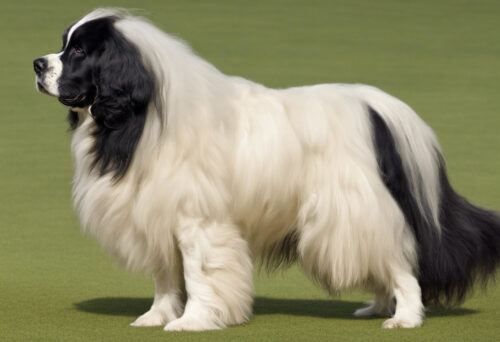Welcome to the ultimate guide to grooming your dog! I often get asked “How do I groom my dog?” And it’s no wonder as grooming is an essential part of pet care that goes beyond making your furry friend look good. It plays a vital role in keeping your dog healthy and comfortable. Regular grooming helps prevent skin issues, reduces shedding, and can even strengthen the bond between you and your pet.
In this comprehensive guide, we’ll cover everything you need to know about grooming your dog at home, from understanding their coat type to establishing a positive grooming routine. We’ll discuss brushing, bathing, trimming fur, nail care, ear care, and dental hygiene – all crucial aspects of grooming that contribute to your dog’s overall well-being.
By following the tips and techniques outlined in this guide, not only will your dog look and feel great, but you’ll also enjoy the benefits of a cleaner home and a stronger relationship with your pet. Plus, you’ll be able to spot potential health issues early on, helping you keep your four-legged companion happy and healthy for years to come.
Get ready to embark on a journey to transform your dog grooming skills and give your pup the pampering they deserve!
Understanding Your Dog’s Coat Type
Different types of dog coats
Before diving into the grooming process, it’s essential to understand your dog’s coat type. There are several common coat types, each with unique grooming requirements:
- Short coat: These dogs have a single layer of short, smooth fur. Examples include Dalmatians, Boxers, and Greyhounds.
- Medium coat: Medium-coated dogs have a single layer of fur that is slightly longer than short coats. Examples include Golden Retrievers, Border Collies, and Australian Shepherds.
- Long coat: These dogs have long, flowing fur that may require more frequent grooming. Examples include Shih Tzus, Maltese, and Yorkshire Terriers.
- Double coat: Double-coated dogs have a dense undercoat beneath their longer outer coat. Examples include German Shepherds, Siberian Huskies, and Pomeranians.
- Curly coat: Curly-coated dogs have tight curls or waves. Examples include Poodles, Bichon Frises, and Irish Water Spaniels.
Grooming requirements for each coat type
Each coat type has specific grooming needs:
- Short coat: Requires regular brushing to remove loose hair and distribute natural oils.
- Medium coat: Requires more frequent brushing to prevent mats and tangles, and occasional trimming to maintain a neat appearance.
- Long coat: Needs daily brushing to prevent mats and tangles, and regular trimming to keep fur manageable.
- Double coat: Requires frequent brushing to remove dead undercoat, especially during shedding seasons. Avoid shaving, as this can damage their coat and cause overheating.
- Curly coat: Needs regular brushing to prevent mats and tangles, and professional grooming every 4-8 weeks to maintain coat health.
Identifying your dog’s coat type and specific needs
To determine your dog’s coat type, closely examine their fur and consult a breed guide or your veterinarian for advice. Once you’ve identified their coat type, you can tailor your grooming routine to their specific needs, ensuring a happy, healthy, and well-groomed dog.

Assembling the Essential Grooming Kit
Brushes and combs for various coat types
To keep your dog’s coat in top condition, you’ll need the right brushes and combs. Here’s a quick guide to choosing the right tool for your dog’s coat:
- Short coat: Use a rubber curry brush or grooming mitt to remove loose hair and stimulate the skin.
- Medium coat: Opt for a slicker brush to remove tangles and a bristle brush to distribute oils and remove loose hair.
- Long coat: Choose a pin brush to gently detangle the fur and a comb to remove small knots.
- Double coat: Use an undercoat rake or deshedding tool to remove loose undercoat, followed by a slicker brush to remove tangles.
- Curly coat: Select a slicker brush to remove mats and tangles, and a comb to maintain curls.
Clippers and scissors for trimming fur
Invest in a pair of high-quality clippers and grooming scissors to maintain your dog’s coat length. Choose clippers with adjustable blade lengths and various guard attachments to achieve the desired cut. Scissors are ideal for trimming delicate areas like the face and paws.
Nail trimmers and grinders
Regular nail maintenance is crucial for your dog’s comfort and health. Choose between scissor-style or guillotine-style nail trimmers, or opt for a nail grinder for a smoother finish.
Dog-safe shampoos and conditioners
Select a dog-safe shampoo and conditioner formulated for your dog’s specific coat type and skin needs. Avoid human shampoos, as they can cause skin irritation and dryness.
Ear cleaning solutions and cotton balls
Purchase a gentle, dog-safe ear cleaning solution and cotton balls to clean your dog’s ears regularly and help prevent infections.
Towels and grooming wipes
Keep a few towels on hand for drying your dog after baths and cleaning muddy paws. Grooming wipes are perfect for spot cleaning between baths.
Optional tools (muzzle, grooming table, high-velocity dryer)
Consider investing in a muzzle if your dog is anxious during grooming, a grooming table for easier access to your dog, and a high-velocity dryer to speed up drying time.
By assembling a well-rounded grooming kit, you’ll have everything you need to keep your dog looking and feeling their best.
Brushing and Combing Techniques
Importance of regular brushing and combing
Regular brushing and combing is crucial for maintaining your dog’s coat health. This process helps remove loose hair, prevent mats and tangles, distribute natural oils, and stimulate the skin for a healthy shine.
Selecting the appropriate brush or comb for your dog’s coat
Choose the right brush or comb for your dog’s coat type, as outlined above, to ensure effective and comfortable grooming.
Step-by-step guide to brushing and combing
- Find a quiet, comfortable space for grooming.
- Gently brush your dog’s coat, working from head to tail and following the direction of hair growth.
- Use long, sweeping strokes for short and medium coats, and shorter strokes for long, curly, or double coats.
- Focus on one area at a time, gently working out any tangles or mats.
- Use a comb to remove small knots and maintain curls for curly-coated dogs.
- Praise and reward your dog throughout the process to create a positive experience.
How to deal with mats and tangles
- Hold the mat or tangle close to the skin to prevent pulling.
- Use a comb or dematting tool to gently work through the tangle, starting from the outside and working your way in.
- If the mat is too tight or large, consider trimming it with scissors or seeking professional help.
Establishing a brushing routine
Create a regular brushing routine based on your dog’s coat type and needs. Short-coated dogs may require weekly brushing, while long, curly, or double-coated dogs may need daily attention. Consistency is key to maintaining a healthy, tangle-free coat.
Bathing Your Dog
When and how often to bathe your dog
The ideal bathing frequency varies depending on your dog’s coat type, activity level, and lifestyle. Generally, most dogs should be bathed every 4-6 weeks. However, dogs with oily or curly coats may need more frequent baths, while dogs with double coats may require less frequent bathing to avoid stripping their natural oils.
Choosing the right dog shampoo and conditioner
Select a dog-safe shampoo and conditioner formulated for your dog’s specific coat type and skin needs. Look for gentle, hypoallergenic, and pH-balanced products to avoid skin irritation and dryness. Some dogs may benefit from medicated shampoos to address specific skin conditions.
Step-by-step guide to bathing your dog
- Gather your supplies, including towels, shampoo, conditioner, and a non-slip mat for the tub or shower.
- Brush your dog thoroughly to remove tangles and loose hair before bathing.
- Place your dog in the tub or shower and wet their coat with warm water, avoiding the face and ears.
- Apply a small amount of shampoo to your dog’s coat, working from the neck down to the tail, and gently massage it in.
- Rinse thoroughly with warm water, ensuring all shampoo is removed from the coat.
- Apply conditioner if necessary, following the same process as shampooing, and rinse thoroughly.
- Gently squeeze out excess water from your dog’s coat and wrap them in a towel to absorb moisture.
- Allow your dog to shake off excess water before towel or air drying, or using a high-velocity dryer on a low setting.
Drying techniques (towel drying, air drying, high-velocity dryer)
Choose the appropriate drying technique based on your dog’s coat type and preferences:
- Towel drying: Gently rub your dog’s coat with a towel to remove excess water.
- Air drying: Allow your dog to air dry in a warm, well-ventilated area.
- High-velocity dryer: Use a high-velocity dryer on a low setting to quickly dry your dog’s coat, especially for long or double-coated dogs.
Tips for making bath time enjoyable for your dog
- Create a calm, comfortable environment for bathing.
- Reward your dog with praise and treats throughout the process.
- Speak to your dog in a soothing, reassuring tone.
- Avoid getting water or soap in your dog’s eyes, ears, and nose.
- Consider using a rubber grooming tool during the shampooing process for a gentle massage.
By following these bathing tips, you’ll ensure a stress-free, enjoyable experience for both you and your dog.
Trimming Your Dog’s Fur
When and why to trim your dog’s fur
Trimming your dog’s fur is essential for maintaining a neat appearance and preventing matting, especially for long and curly-coated dogs. Regular trimming also helps keep your dog’s fur clean and free from debris, reduces the risk of overheating, and can improve your dog’s overall comfort.
Clippers vs. scissors: pros and cons
Clippers: Electric clippers are ideal for trimming large areas quickly and maintaining a uniform length. They can be noisy and may startle some dogs, so it’s essential to familiarize your dog with the sound and vibration before use.
- Pros: Efficient, consistent length, adjustable blade lengths.
- Cons: Noisy, may scare some dogs, requires maintenance.
Scissors: Grooming scissors are perfect for trimming delicate areas like the face and paws and for dogs who are anxious about the noise and vibration of clippers.
- Pros: Quiet, precise, suitable for delicate areas.
- Cons: Time-consuming, requires steady hands, less consistent length.
Step-by-step guide to trimming your dog’s fur
- Brush your dog thoroughly to remove tangles and loose hair.
- Choose the appropriate tool (clippers or scissors) for your dog’s coat and preferences.
- If using clippers, select the desired blade length and attachment guard.
- Begin trimming your dog’s fur, working from the neck down to the tail, following the direction of hair growth.
- Trim sensitive areas like the face, ears, and paws carefully, using scissors if necessary.
- Check your work as you go, ensuring an even and smooth finish.
- Praise and reward your dog throughout the process to create a positive experience.
Tips for maintaining your dog’s coat between grooming sessions
- Regularly brush your dog’s coat to prevent mats and tangles.
- Use grooming wipes to spot clean dirty areas.
- Monitor your dog’s coat for signs of excessive growth, matting, or skin issues.
When to seek professional help for grooming
If you’re unsure about trimming your dog’s fur, facing stubborn mats or tangles, or dealing with a nervous or aggressive dog, it’s best to seek the help of a professional groomer. They have the expertise to safely groom your dog and can provide valuable advice for maintaining your dog’s coat at home.
Regular trimming will not only keep your dog looking their best, but it will also contribute to their overall comfort and well-being.

Nail Care for Dogs
Importance of regular nail trimming
Regular nail trimming is crucial for your dog’s comfort, mobility, and overall health. Overgrown nails can cause pain, difficulty walking, and may lead to posture issues, joint problems, and even injuries.
Choosing the right nail trimming tool
Select the appropriate nail trimming tool for your dog’s size and your comfort level:
- Scissor-style trimmers: These trimmers have a cutting mechanism similar to scissors and are ideal for small to medium-sized dogs with thinner nails.
- Guillotine-style trimmers: These trimmers have a small hole where you insert your dog’s nail, and a cutting blade that slides across when the handle is squeezed. They work well for small to medium-sized dogs with thinner nails.
- Nail grinders: These electric tools use a rotating grinding bit to file down your dog’s nails. They’re suitable for dogs of all sizes and are less likely to cause accidental injuries.
Step-by-step guide to trimming your dog’s nails
- Familiarize your dog with the nail trimming tool by letting them sniff and inspect it.
- Choose a quiet, well-lit area for nail trimming.
- Gently hold your dog’s paw, and separate the toes to expose the nail.
- Identify the quick (the pinkish area inside the nail) and avoid cutting into it to prevent pain and bleeding. If your dog has black nails, trim small amounts at a time until you see a small white or gray dot in the center.
- Carefully trim or grind the nail, removing small portions at a time and avoiding the quick.
- Smooth any rough edges with a nail file or the grinder’s smoothing attachment.
- Praise and reward your dog throughout the process to create a positive experience.
Tips for making nail trimming less stressful for your dog
- Start nail trimming when your dog is young to help them become comfortable with the process.
- Trim your dog’s nails regularly to prevent the quick from growing too long.
- Associate nail trimming with positive experiences, like treats and praise.
- Keep styptic powder or cornstarch on hand to stop bleeding if you accidentally cut the quick.
By maintaining your dog’s nails with regular trimming, you’ll promote their comfort, health, and overall well-being.
Ear Care and Teeth Cleaning
Importance of ear care for dogs
Regular ear care is essential for your dog’s health, as it helps prevent infections, remove debris, and minimize unpleasant odors. Dogs with floppy ears, long hair, or those prone to allergies may be at a higher risk of developing ear infections and require more frequent ear cleaning.
Step-by-step guide to cleaning your dog’s ears
- Gather your supplies, including a dog-safe ear cleaning solution and cotton balls or pads.
- Hold your dog’s ear flap up to expose the ear canal.
- Apply a small amount of ear cleaning solution to the opening of the ear canal.
- Gently massage the base of the ear for 15-20 seconds to help loosen debris.
- Allow your dog to shake their head to help dislodge debris.
- Use a cotton ball or pad to gently clean the visible parts of the ear, avoiding the ear canal.
- Praise and reward your dog throughout the process to create a positive experience.
Importance of dental care for dogs
Dental care is crucial for maintaining your dog’s overall health, as it helps prevent gum disease, tooth decay, and bad breath. Regular teeth cleaning can also reduce the risk of serious health issues, such as heart and kidney disease, caused by bacteria entering the bloodstream through the gums.
Step-by-step guide to cleaning your dog’s teeth
- Gather your supplies, including a dog-safe toothpaste and a soft-bristled toothbrush or finger brush.
- Familiarize your dog with the taste of the toothpaste by letting them lick a small amount off your finger.
- Gently lift your dog’s lips to expose their teeth.
- Apply a small amount of toothpaste to the toothbrush or finger brush.
- Gently brush your dog’s teeth in small circular motions, focusing on the outer surfaces and gumline. Be patient and work at your dog’s pace.
- Praise and reward your dog throughout the process to create a positive experience.
Establishing a routine for ear care and teeth cleaning
Create a regular routine for ear care and teeth cleaning based on your dog’s needs. In general, clean your dog’s ears every 2-4 weeks and brush their teeth daily or at least 2-3 times per week. Consistency is key to maintaining your dog’s ear and dental health.
By taking care of your dog’s ears and teeth, you’ll promote their overall health and well-being, while preventing potential health issues.
Recognizing and Addressing Common Grooming Challenges
Dealing with anxious or fearful dogs during grooming
- Start grooming sessions early in your dog’s life to help them become comfortable with the process.
- Create a calm, quiet environment for grooming and use a gentle, reassuring tone when speaking to your dog.
- Use positive reinforcement, such as treats and praise, to create a pleasant experience.
- Take breaks as needed and keep grooming sessions short, gradually increasing the duration over time.
- Consider using a muzzle or seeking professional help if your dog’s anxiety is severe.
Handling aggressive behavior during grooming
- Determine the cause of aggression, such as fear, pain, or territoriality, to better address the issue.
- Consult with a professional dog trainer or behaviorist for guidance on managing aggressive behavior.
- Use a muzzle for safety during grooming sessions.
- Seek the help of a professional groomer if you’re unable to safely manage your dog’s aggression during grooming.
Addressing skin issues and allergies
- Inspect your dog’s skin regularly for signs of irritation, redness, or inflammation.
- Choose hypoallergenic, fragrance-free grooming products to minimize the risk of skin irritation.
- Consult with your veterinarian for advice on treating and managing skin issues and allergies.
Managing shedding and hair control
- Brush your dog regularly to remove loose hair and reduce shedding.
- Use a deshedding tool or undercoat rake for double-coated dogs to remove excess undercoat.
- Consider professional grooming services to help manage shedding during peak seasons.
- Use furniture covers and lint rollers to minimize pet hair in your home.
When to seek professional help for grooming
Consider seeking professional help for grooming if:
- You’re unsure about grooming techniques or tools.
- Your dog has severe matting or tangles that you can’t safely address.
- Your dog is anxious, fearful, or aggressive during grooming.
- Your dog has specific health issues or grooming requirements that you’re unable to manage.
By recognizing and addressing common grooming challenges, you can create a safe, comfortable, and enjoyable grooming experience for both you and your dog.

Conclusion
Caring for your dog’s grooming needs is a vital part of maintaining their overall health, well-being, and appearance. By following the tips and techniques outlined in this article, you can confidently groom your dog at home and keep them looking and feeling their best.
Remember to:
- Understand your dog’s coat type and specific grooming requirements.
- Brush and comb your dog’s fur regularly to prevent matting and maintain a healthy coat.
- Bathe your dog using appropriate shampoo and conditioner, based on their coat type and skin needs.
- Trim your dog’s fur, nails, and perform regular ear care and teeth cleaning to promote their comfort and health.
- Address common grooming challenges with patience, positive reinforcement, and the help of professionals when necessary.
By establishing a consistent grooming routine and providing your dog with a positive experience, you’ll not only strengthen the bond between you and your furry friend, but also ensure their lifelong health and happiness. Happy grooming!



